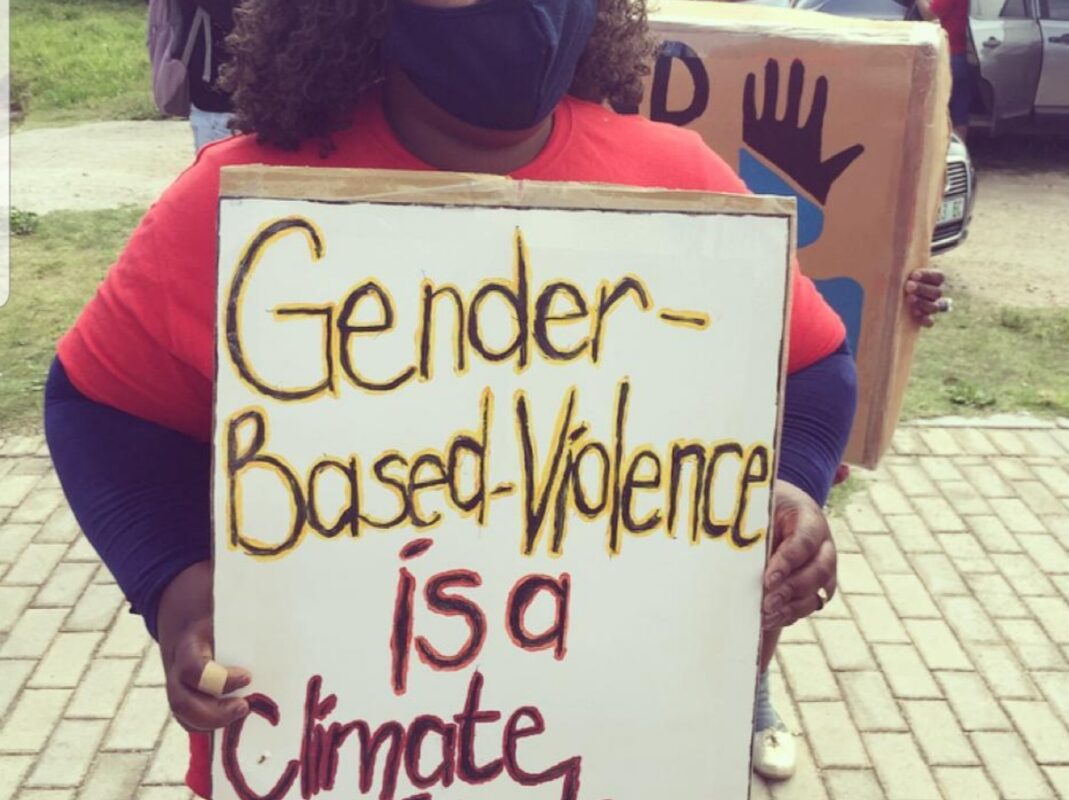From People and Nature
The fight against climate change is not only a struggle to keep our planet liveable. For many women, rising temperatures can be a direct cause of violence.
Understanding connections between heat and violence is increasingly important as we witness the warming of our planet, and anticipate more intense and longer-lasting heatwaves, writes Orthalia Kunene.
In most parts of South Africa, temperatures already often exceed 40°C.
While violence in South Africa has often been attributed to its unique historical, social and
economic characteristics, the potential contribution of physical environmental factors, such as heat, has largely been ignored.
But a study using data from all 1158 police wards in South Africa documented higher levels of violence, including homicides, during periods of high temperature.
In Tshwane, Gauteng Province, a study assessed five years of temperature and crime data – and found that the number of violent crime incidents was about 50% higher on high-temperature days, compared with low-temperature days and with random days selected from the dataset after the warmest and coldest days had been extracted.
Another study in the same area noted seasonal patterns in crime, with violence most frequent in the summer months.
Francina Nkosi, national coordinator for Women Affected by Mining United in Action (WAMUA), says: “Around the world, climate change-induced crises have been shown to worsen violence against women. South Africa is considered a water-scarce country, and the 30th driest country in the world. At times of prolonged drought, women and girls make more frequent and longer journeys to obtain water, which makes them vulnerable to sexual violence”.
The problems caused by climate change are often piled upon those caused by poverty.
“In most mining affected communities, men leave home to seek a living in the cities, women, and children are left to fend for themselves, which makes them vulnerable to violence and sexual exploitation”, Nkosi said.
“Poor harvests, livestock loss, lower earnings, and food insecurity put pressure on men’s traditional role as providers. They often turn to alcohol to bear with the pressure and become more violent, towards their partners. The impacts of gender-based violence are severe and affect all members of the community. “
The studies showing that women suffer higher levels of physical and sexual violence in hot weather are especially concerning in South Africa given the already high background levels of violence against women and a femicide rate among the highest in the world. In 2019, more than 2700 South African women and 1000 children were killed, according to police figures.
Why do higher temperatures increase the risk of violence?
Research has proven that changes in weather conditions, especially temperature, can profoundly influence physiology and behaviour. Heat exposure has a range of physiological impacts, affecting levels of comfort, emotional stability and sense of wellbeing.
Being in an uncomfortably hot environment creates irritability and aggressive thoughts, and reduces positive emotions such as joy and happiness. Men appear to be particularly sensitive to the effects of heat on aggression. Hot weather also alters behaviours, for example resulting in people tending to congregate outdoors, with increased opportunities for contact crimes and violence.
Additionally, alcohol use, a potent trigger for violence, can increase during hot weather, while dehydration, more common on hot days, is associated with mood disturbance, confusion and anger. It is therefore plausible that together these physiological and behavioural pathways may increase the likelihood of violence, particularly violence committed with the intention of harming other persons rather than violence where the aim is primarily to gain assets, such as robberies.
Natural disasters and sexual violence
Climate change increases the risk of storms and disasters related to them – and these, in turn, increase the risk of violence against women.
At least 15,000 women and girls in the areas affected by Cyclone Idai, which devastated parts of southern Africa in March 2019, are at risk of gender-based violence linked to disruptions caused by the storm, a recent report by the UN Resident Coordinator in Zimbabwe stated. There were several reports were made of young girls who suffered sexual abuse in a community in eastern Zimbabwe hit hard by the cyclone.
There were also concerns about women and girls being asked to provide sex in exchange for access to aid. Meanwhile, a UN Flash appeal report has noted the lack of privacy and lighting in camps for displaced persons, which can increase the risk of violence and transactional sex for female storm victims.
This situation is, unfortunately, not unique to Cyclone Idai. In Africa, the violence of climate change is already being felt in many different ways.
The changing weather patterns, heavier rainfalls, prolonged droughts, increased crop failure, livestock loss, and increasing food insecurity are affecting women and girls the most.
Women find themselves being forced to trade sex in exchange for food or rent; even attempts by women to negotiate, providing labour in exchange for food, are often rejected, Francina Nkosi of WAMUA says.
“In most disasters, women and girls are worst affected”, concluded a report by CARE (a global movement trying to save lives, defeat poverty and achieve social justice). It said that one out of five women who are refugees or who have been displaced because of a natural disaster has experienced sexual violence.
Many women are displaced during and after disasters, and that can lead to an increase in violence, due to overcrowded and unsafe living conditions in evacuation centres and temporary shelters.
What academic research shows
Sixteen articles about the relationship between rising temperatures and violence were located through targeted searches of Google Scholar and from experts in the field. Nine of the 16 studies reported an increase in homicides with a rise in temperature. While the remaining studies did not detect a significant association, they were all in the direction of a positive effect.
Effect size ranged widely; from small effects in some studies in the USA to an estimated 17% increase in homicides per year in Africa where the temperature increase by 1°C. The findings of these studies point to a conservative estimate of a 4-5% increase in homicides per degree rise in temperature.
Countries like South Africa, which already have high levels of violence and a rapidly warming climate, are vulnerable to the consequences of climate change. We are more likely to see an

Representatives from shelters for abused women demanding more funding outside South Africa’s parliament in 2019. Photo: Eloise Schrier
increase in the number of cases of homicide and other forms of violence per year should the temperature rise by 1°C, signalling the potential for an even greater burden of violence, centered on already vulnerable groups (women and girls).
Moreover, other consequences of climate change, such as extreme weather events, will influence “eco-migration” and conflict over food and water.
Researchers from Princeton University and the University of California-Berkeley report in the journal Science that even slight spike in temperature has greatly increased the risk of personal violence.
They also found that while climate is not the sole or primary cause of violence, it undeniably worsens pre-existing social and interpersonal tension in all societies, regardless of wealth or stability.
The increase of heat or rainfall can also increase the risk of a riot, civil war, or ethnic conflict by an average of 14 per cent. There is a 4 per cent chance of a similarly sized upward creep in heat or rain sparking person-on-person violence such as rape, murder, and assault. The magnitude of violent, sexual and, property crime is higher on hot days compared to cold or random temperature days.
Researchers analysed 60 studies from several disciplines — including archaeology, criminology, economics, and psychology — that have explored the connection between weather and violence in various parts of the world from about 10,000 BCE to the present day.
Importantly, the degree to which heat impacts violence varies across settings and is contingent on factors such as gun control, gender inequalities, substance abuse, and socioeconomic vulnerability. One study in the USA, for example, showed that associations between heat and violence were considerably stronger in areas with the highest levels of social disadvantage.
Globally, women are more likely to be vulnerable to violence because of the pre-existing inequality towards them.
Women’s historic disadvantages – their limited access to resources, restricted rights, and a muted voice in shaping decisions – make them highly vulnerable to the violence caused by rising temperatures increasing aggression, and violent behaviour.
Conclusions
Women, girls, LBTQI (lesbian, gay, bisexual, transgender, queer, and intersex), and gender non-conforming people are always among the hardest hit by the climate crisis. These groups often face increased sexual violence, unsafe labour, and an inability to reach medical centres. Climate disasters can impose terrible hardships.
While we cannot prevent these events from occurring, we can ensure that, for women and girls, climate-related disasters do not continue to rage in the form of violence.
According to Francian Nkosi, investing in women and girls creates ripple effects felt throughout entire communities and countries. Research shows that countries with high representation of women in parliament are more likely to uphold international environment agreements. Climate change, livelihoods, and violence against women and girls are extremely important intersections.
Without women’s full participation and freedom from violence, oppression, and discrimination, our efforts to address the climate crises will be an absolute failure. 1 March 2021




